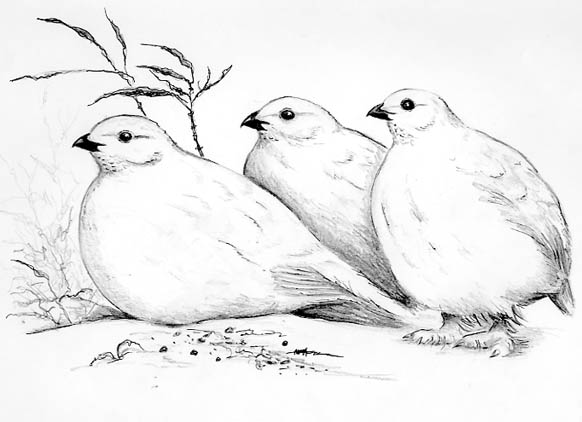
Dear Bird Folks,
How embarrassing is this? My ten-year-old son was assigned a school project in which he had to identify a particular state bird. The state assigned to him was Alaska. It was bad enough that he had to look it up in our outdated world almanac, but when he finally found the name of Alaska’s state bird, he couldn’t pronounce it and I couldn’t help him. What exactly is a “ptarmigan” and why would they give that bird a name that’s so hard to pronounce?
– Natalie, Raleigh, NC
I totally agree, Natalie
If you are upset about this bird’s name, so am I. I know I’m usually not this agreeable, but I have a good reason to be. At a talk at a local library last year a guy in the audience was very annoyed over several bird names that he felt were “misleading.” Among other things, he wasn’t happy that there isn’t a noticeable “red belly” on a Red-bellied Woodpecker. When I made the mistake of trying to explain the origins of the names in question the guy became even more upset. Fortunately, I was able to hide behind the seventy-year-old librarian until the guy calmed down. But ever since that day I agree with anyone who questions any bird names. I find it safer that way. I can’t always depend on a librarian being around when I need one.
I actually do agree with you on the name of this bird, Natalie. Ptarmigan is a tricky one. The name is derived from Scottish Gaelic and is pronounced tar-mi gen. I have no idea why they felt they needed to add a silent “p” to the beginning of it, except perhaps to bug us. Five hundred years ago just about every word in the English language was pronounced like it was spelled; however, as words from other languages started working their way into English, so did the nutty concept of silent letters. Today nearly sixty percent of all English words are not spelled the way they sound, including the mother of all ironies, the word “phonics.”
A ptarmigan is a grouse of the North country. There are three species of ptarmigan in North America, with the largest and most common being the Willow Ptarmigan. The Willow Ptarmigan, as you already know, is the state bird of Alaska. The people of Alaska honor their state bird in several ways, including eating it whenever they can. Ptarmigans can be found all across the top of North America, in the British Isles, in Scandinavia and in northern Russia, where they are called ![]() . And you thought the silent “p” was a challenge.
. And you thought the silent “p” was a challenge.
Like most grouse, ptarmigans spend most of their lives on the ground. They also live in an area of limited cover. To help avoid their enemies, ptarmigans have evolved an assortment of cryptic plumages. Most other birds have two molts per year, but ptarmigans have three. In the spring their heads and necks are brown or rusty, with mostly white bodies. This two-tone coloring blends them in perfectly with the earth and snow patches of their changing northern landscape. Come summer, when all the snow is gone, so is most of their white feathering and the bird becomes a generic brown. When the snow starts to fly, the ptarmigans molt into their signature white coats. With the exception of their eyes, beak, and a few black tail feathers, which the birds can easily keep hidden, they are a perfect snow white. Trying to locate a ghost in the fog would be easier than trying to spot a ptarmigan in the winter.
During the winter the birds must deal with ultra-frigid temperatures and copious amounts of snow. The latter can be a big problem for any ground-dwelling bird. To survive in such harsh conditions ptarmigans have evolved some useful adaptations. For instance, the birds’ legs and feet are covered in feathers. This not only helps with insulation, but the feathered feet form handy snowshoes, allowing the birds to walk easily on top of the soft snow. At night, or when the daytime weather turns nasty, these resourceful birds dig burrows into the nearest snow bank. They remain there until conditions improve, or until they find out that school has been canceled and they can go outside to play.
If you ever get a chance to visit Alaska, finding a Willow Ptarmigan should be on your to-do list. The birds can be rather tame and quite approachable. However, keep your distance from their nests. The aggressive males do an excellent job of protecting the family. They have been known to fly directly at predators, knocking over gulls, or smacking right into humans and even grizzly bears. Don’t mess with a daddy ptarmigan.
Ptarmigan is indeed an odd name for a bird, Natalie, so you shouldn’t feel embarrassed about your pronunciation. And because of where they live, and perhaps because of their funky name, they have evolved into being tough, hardy birds. If you ever feel threatened, you would be wise to hide behind a male ptarmigan. They provide great protection, second only to the protection provided by seventy-year-old librarians.